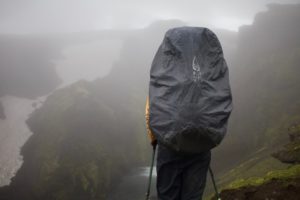by Katherine Solohub, May-program high school intern at the Minnesota Land Trust


Katherine on Farm Island Lake, MN
In ninth grade as a part of a religion course at my school, I was asked when religion is most present in my life. Although the two words are frequently considered to be synonymous, I do not consider myself a religious person, but rather a spiritual person. So I revised the question to ask where or when I feel connected to something greater than myself in a spiritual sense. Nature was the obvious answer. It is when I am surrounded by trees, mountains, prairie lands and other natural landscapes that I feel as though there is a greater force than humans, the essence of spirituality.
However, I do not feel that this is the case for most young people these days. I have been fortunate enough to travel to different locations around the world all for the sake of hiking and being in nature. When I mention this to my classmates or other teenagers the usual response is to ask why I would do that when I don’t have access to my phone. I tell them that life is much simpler without a phone and you get to be in the moment and experience the things that are around you. There is the occasional teenager who shares similar experiences and we proceed to swap hiking stories; however, the majority opt not to leave the safety of their home for two weeks in the woods (not to mention cell service is terrible in the woods.)
From my observations, kids are choosing to stay inside more, shutting themselves in their rooms, only to be on social media where they craft unrealistic expectations of life. It would be wrong of me to criticize this, however, when I do this myself. No one is immune to technology, not even adults who also fall into this generalization. The question then becomes, how do we get kids outside and more importantly how do we get kids to want to go outside and enjoy nature?


Rangárbing Ytra, Iceland
Meeting kids where they are, and marketing the outdoors as a shareable, “Instagram worthy” opportunity could be one solution. Teenagers and kids these days can be concerned with the aesthetic of the outdoors more than the actual experience of outdoors, particularly if they haven’t had much experience exploring outside. Even if they’re just there to take pictures to share, just the act of getting out into nature is one small step forward. By marketing nature to teenagers, it will get kids outside and who knows, they may even put their phone down inbetween photos and feel something greater than themselves. Or perhaps they won’t, but proceed to tell their friends about how great a photo they got at a park. One of them could have that epiphany, life changed forever.
That type of engagement isn’t necessarily a heavy lift for conservation organizations either. For example, one photo-based social media platform that the Minnesota Land Trust could explore is Snapchat. This is a platform that mostly younger kids, teenagers, and millennials are using. Snapchat is more casual, and volunteer land monitors could use it to post pictures to a Land Trust Snapchat Story when they’re out in the field.
Additionally, I would suggest conservation organizations refine their social media accounts and direct them to the average age of their users. For example, Facebook generally has an older use base, whereas Instagram is mainly a younger demographic. Therefore, Facebook and Instagram posts should be different in message and content. The most popular conservation accounts on Instagram post beautiful pictures and are usually accompanied by a caption about the location of the photo. The trick with the caption is to keep it short and sweet. Perhaps link the Minnesota Land Trust blog in the biography of the account where the link pertains to the latest picture and the link is updated with every post. However with Facebook, the pictures needn’t be the main focus, and you can be more focused on getting a message across with longer captions that go into more detail.
Don’t get me wrong, there are teenagers and kids out there who love to be outdoors. But the fact of the matter is, they are a minority amongst those who are on their phone and have a fear of the lack of cell service in outdoor areas. There are ways to get kids outside, and enjoying nature; however, conservation organizations have to work to meet them where they are, and not just rely on traditional methods.





